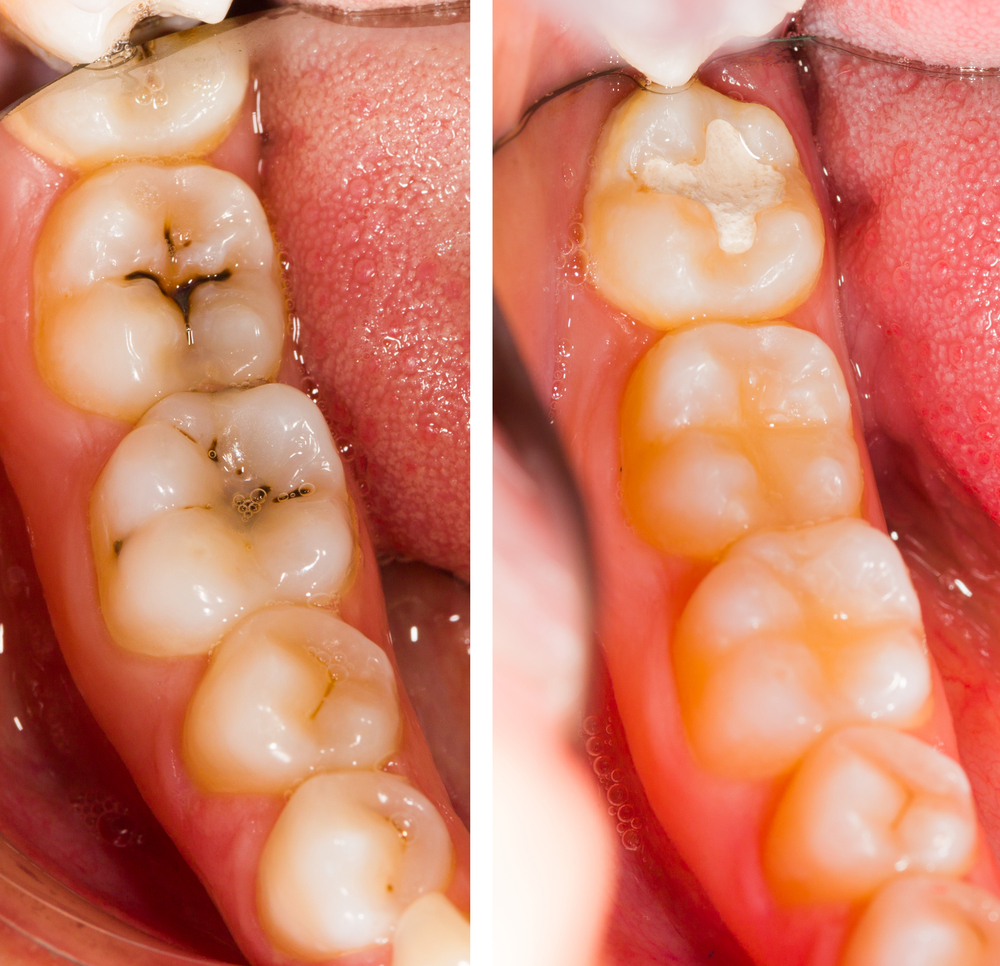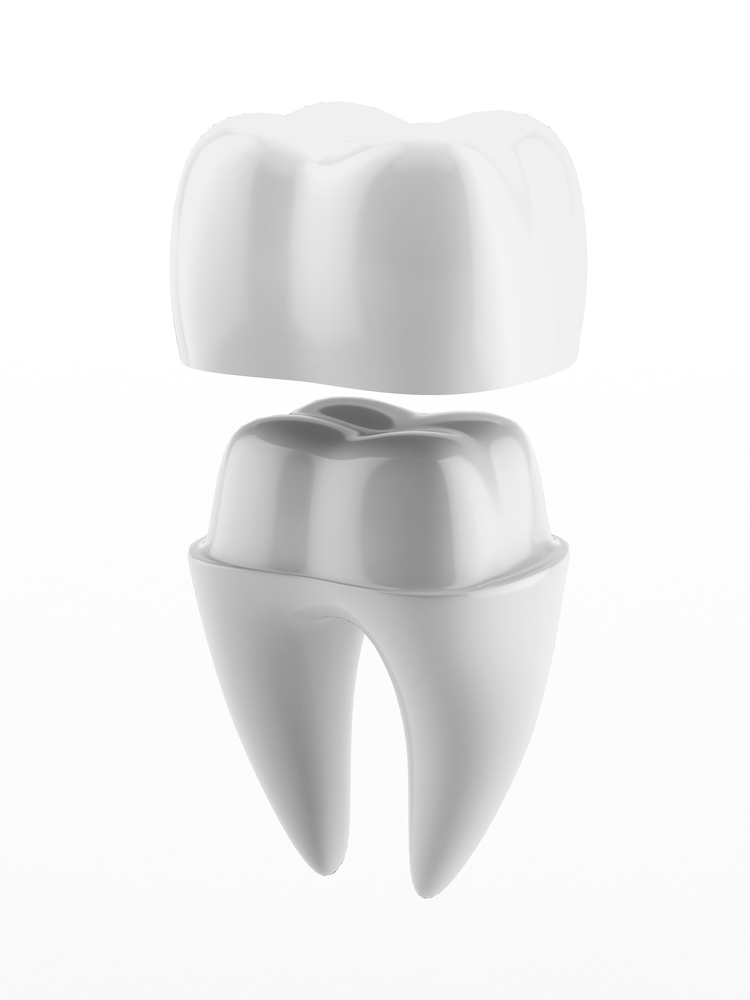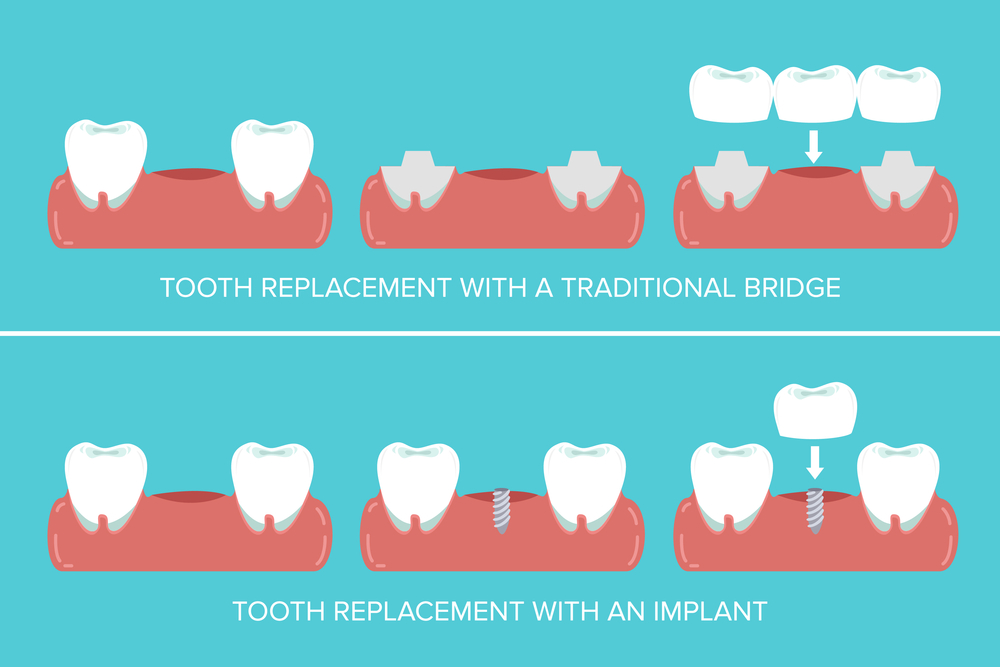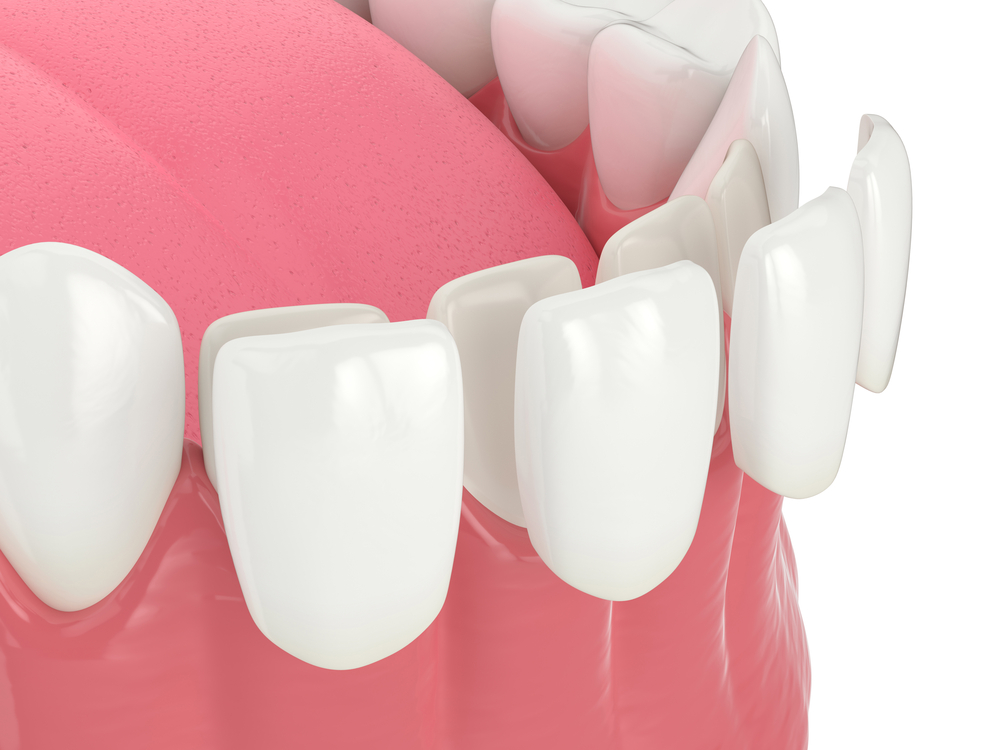

Dental restoration is is a set of dental procedures that are done if you have missing, decayed, weakened or fractured teeth. There are many different cosmetic dentistry practices that can help fix a wide range of dental concerns, whether you have an infected tooth, cracked teeth or are in need of full mouth restoration.
Restorations such placing a dental bridge, dental implants or dental crowns can help completely restore missing teeth, or help retain the healthy part of patient’s teeth that still remain. Dental restorations can not only improve oral health, but make sure further damage is minimized. Better yet, it can provide patients with improved confidence knowing a great smile is achievable, no matter the extent of their dental damage.
There are several types of dental restoration procedures a dental office is able to handle. For example, decay and deterioration may be handled differently, depending on the patient. Sometimes partial dentures can be the answer, while in other cases repair may be approached removing an infected tooth, deciding to implement a few root canals, or inserting a bridge. When it comes to achieving a beautiful smile — cosmetic dentists have a lot of tricks up their sleeves.
Let’s take a look at some of the most common types of dental work and dental restoration procedures:
Almost everyone has a filling as fillings are the most common type of dental restoration. When you have a cavity or have minor tooth decay, a dentist will fill that cavity — or hole — in your teeth with a material to stop the spread of the decay. Traditionally, fillings were made from gold and silver amalgam. But today it’s much more common for a dentist to use tooth-colored plastic and composite resin fillings.
Composite resins (white filling): These are a contemporary material used for dental fillings, and are now the preferred medium. Not only do they blend with the natural color of your teeth, unlike metal they don’t expand or contract (which can also lead to damaged teeth). They’re just as durable and effective as the old school metal fillings.
Glass ionomer. This approach functions more like a sealant, but is opaque (typically it’s not tooth colored) and protects from further decay for other teeth.
Resin-modified glass ionomer. This is the longer-lasting, more natural option as the resin matches tooth enamel better and typically lasts a bit longer than glass ionomer.



Bridges, or what’s sometimes called a “fixed partial denture” help replace damaged teeth by creating a bridge between missing teeth. These bridges are adhered within the mouth by crowns — tooth-shaped caps which are placed over a tooth to restore its natural appearance and strength. Crowns are typically cemented permanently into place.
During a consultation, the dentist will help you decide which type of dental bridge would work best. Some of the most common include:
Traditional Dental Bridge. Here, one dental crown is adhered to the surrounding teeth with either a fake tooth or a set of teeth in the between. Here, the dental crowns act as an anchor while the fake tooth or teeth bridge the gap. A benefit of traditional bridges is their strength.
Maryland Bonded Bridge. This is almost identical to the traditional bridge except a metal or porcelain structure is used for the framework and adheres to the back of the teeth instead of the side. This is a more affordable approach but the framework can sometimes vary in strength and occasionally causes discoloration.
Cantilever Dental Bridge. This option uses one anchor tooth to adhere the bridge to the mouth, however this is often not as stable and can only be used to repair gaps toward the front of the mouth.
Implant-Supported Bridge. This approach is very similar to the traditional bridge, but instead of crowns, dental implants are used to support the bridgework. This is a very durable approach, however it’s much more invasive and requires longer recovery.
In many of these procedures, there may need to be an even reduction around the damaged tooth so that the crown will restore the size and shape of the tooth. This can sometimes be a long process and may involve having an impression made of your teeth while a a temporary crown is placed in the meantime. The good news is, many cosmetic dentist offices have CEREC technology which can fabricate a crown while you’re in-office!
Made from titanium or a titanium amalgam, implants act as anchoring posts which are often placed into the bone of the jaw where a tooth, or multiple teeth are missing. Think of implants as artificial “roots” that hold replacement teeth (as we discussed above with crowns and bridges) in place.
Dental implant types include:
Endosteal. With an endosteal implant, the artificial root is drilled and then placed directly into the jawbone.
Subperiosteal. With subperiosteal implants, the artificial root is placed either on or above the jawbone. Usually, this is the option which is chosen when the jaw bone is not strong or healthy enough to withstand the drilling an endosteal implant requires.


Unlike most bridgework, dentures are a removable replacement for missing or damaged teeth. Whether your teeth have decayed due to gum disease or you’ve sustained an injury, dentures can help mask the missing or damaged teeth so you can feel more confident about your smile. Your dentist can help you decide whether you may need either complete dentures which replace all the teeth OR partial dentures which are adhered to some of the remaining healthy teeth with metal clasps.
There are three types of dentures:
Conventional. This is a removeable option which can be used after infected teeth are removed and the surrounding tissue has healed.
Immediate. Also removeable there’s no wait to enjoy your new look with immediate dentures.
Overdenture. An overdenture is used when some healthy teeth remain. Typically, this will fit over the remaining teeth.
If you’ve struggled with yellowing and you want to not only whiten but change the shape of your teeth, veneers are a procedure which cover your teeth with a thin, porcelain or composite resin shell that correct and perfect the look of your natural teeth. With proper care veneers can last between five and fifteen years.
Veneers help with:
Unusually small teeth
Uneven or chipped teeth
Discoloration

Discoloration or cracking can also be repaired using a tooth bonding method in which your dentist applies a color-matched, composite resin material to your tooth. The dentist can then mold and shape the resin before setting it with an ultraviolet light. Unfortunately, this option is not quite as hardy as a veneer and may need to be repaired more consistently.
While damaged tooth enamel can’t be restored there are some things that can be done to help strengthen the enamel. Dentists can use sealants to help prevent enamel loss or damage. These are typically adhered to each individual tooth and hardened in place with ultraviolet light.

Usually, in-office professional whitening treatments can be completed in one or more short appointments. This process includes the application of a whitening agent which is left on for 15- to 30-minute increments.
There are a few types of in-office whitening treatments:
Gel whitening. A high concentration of hydrogen peroxide gel is applied to the teeth by a syringe.
Laser whitening. A hydrogen peroxide mixture is applied and then combined with a high-intensity light (like LED, UV or halogen.) Once the mixture has been put on your teeth, a light — which is applied by a lamp or laser device — shines over your teeth and sets the mixture.
Take-home trays. Typically, this option begins in the dentist chair, but then requires the patient to continue the process at home. With a professional take-home-tray, your dentist will make a custom impression of your teeth. Because this tray will fit your mouth perfectly, it will typically give you better results than drugstore options. Often, the take-home whitening solution is not quite as potent as the in-office mixture to help protect your gum and other tissues from irritation, so while it may take a bit longer to get the same results, it’s important to stay diligent.
For most restorative dental procedures you’ll need to be mindful of your aftercare. Of course, what you’ll need to do will depend on the dental work you’ve had done and will be personalized, by your dentist, to your unique needs.
Take good care of your teeth (both organic or newly made for you!) by cleaning and flossing them every day, and going to all your follow-up appointments. Don’t forget to care for your gums, tongue and the roof of your mouth!
It’s important to stay ahead of dental problems by seeing your dentist regularly. If you have painful teeth and gums, or notice any signs of infection, it’s time to give your dentist a call. The team at San Diego Art of Dentistry are master clinicians who understand the unique needs of comprehensive cosmetic dental care.
Their friendly staff can help set you up with your first visit. Give them a call today to schedule an appointment and before you know it you’ll be able to realize the beautiful smile of your dreams.
Located in San Diego, CA, the Art of Dentistry dentists are consistently recognized as top in their field by their peers. The Art of Dentistry prides itself on their highly experienced and skilled staff. They understand that, just like other artists, each specialist has their own unique talents. To take full advantage of that, they have developed a team of top specialists to work collaboratively and provide you with comprehensive care that results in a magnificent smile. They offer target skillsets, advanced technology, customized treatment plans, comprehensive restorative dentistry as well as general dentistry, and much more.